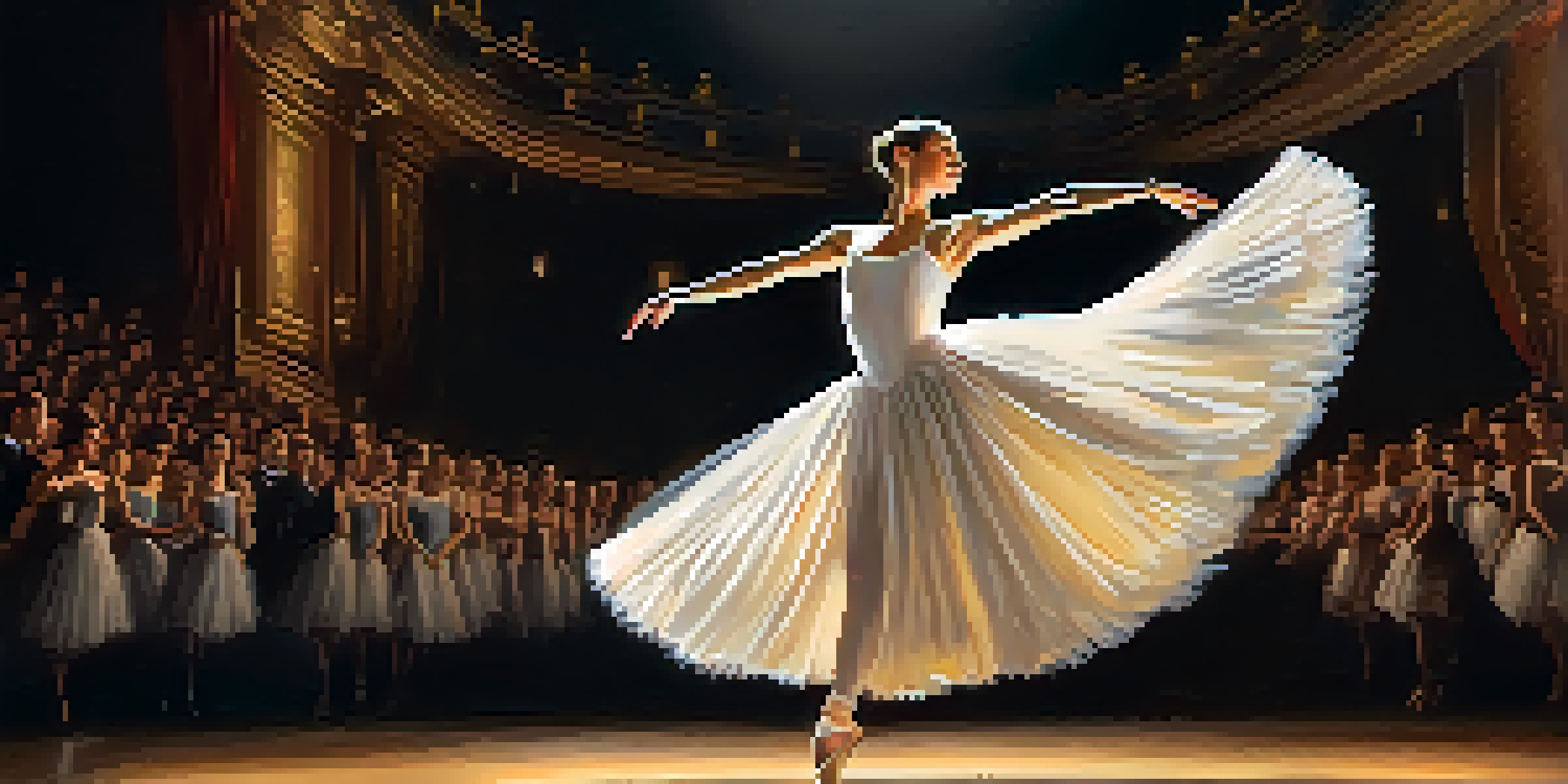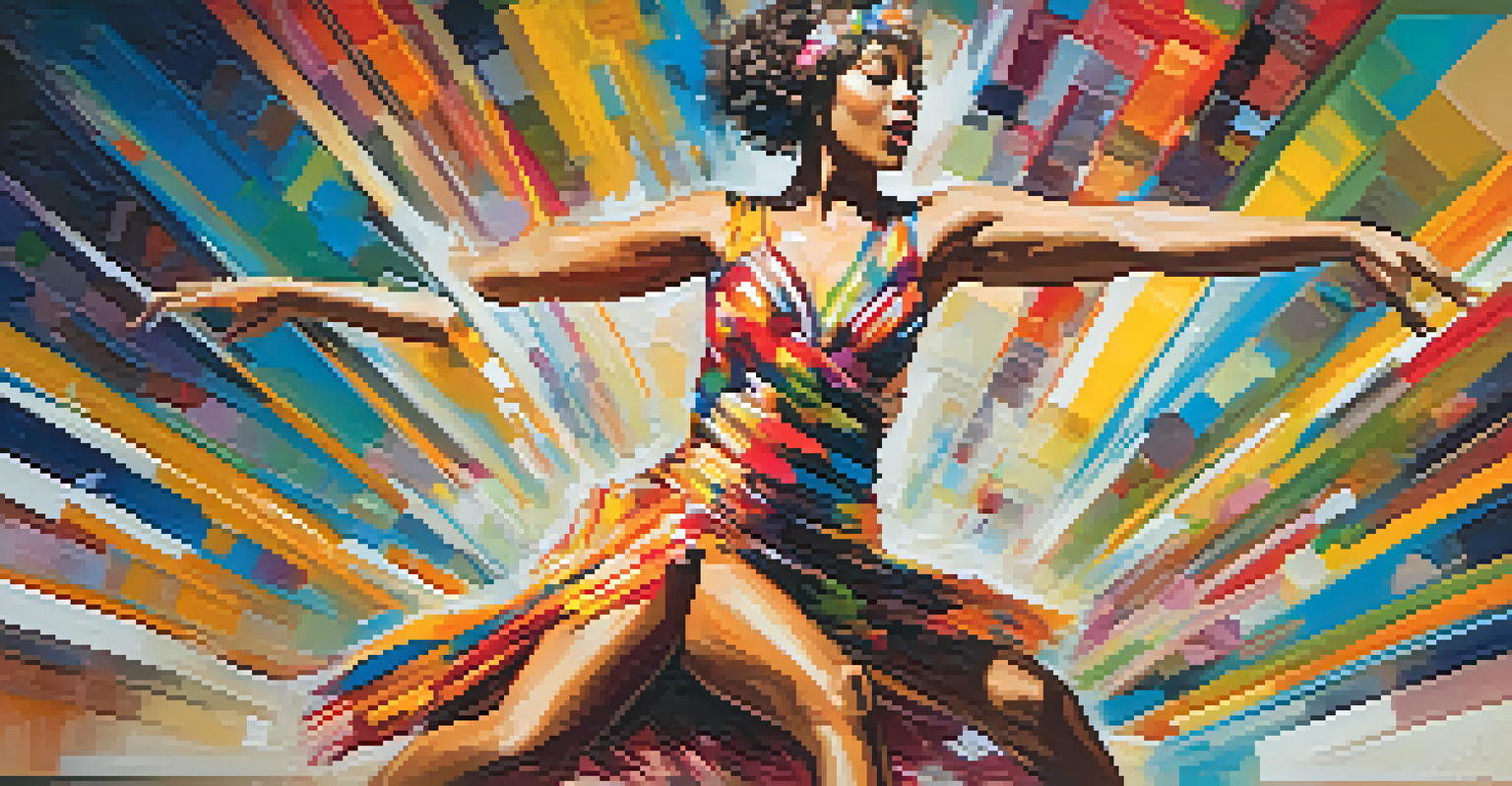The Evolution of Dance Fashion: From Classical to Contemporary

Classical Dance: The Birth of Elegance and Structure
Classical dance fashion emerged with elegance and precision, epitomized by the tutus and pointe shoes of ballet. These garments were designed to enhance movement while adhering to the strict forms of classical choreography. The use of lightweight fabrics allowed dancers to express both grace and strength, establishing a standard for beauty in movement.
Dance is the hidden language of the soul.
In the 19th century, iconic figures like Marie Taglioni popularized ethereal costumes that gave the illusion of weightlessness. This transformation not only influenced ballet but also set the stage for future dance genres. The focus on structured silhouettes and intricate detailing became the hallmark of classical dance attire.
As ballet evolved, so did its fashion, incorporating rich fabrics and elaborate ornamentation to reflect the stories being told. The combination of artistry and functionality in classical dance costumes laid the groundwork for the diverse styles we see today, marking a pivotal point in the evolution of dance fashion.
Jazz and Swing: Freedom and Individuality in Dancewear
With the rise of jazz and swing in the early 20th century, dance fashion took a turn towards freedom and individual expression. Dancers began favoring loose, comfortable clothing that allowed for improvisation and energetic movements. This shift marked a departure from the rigid structures of classical dance attire.

Outfits like flapper dresses and high-waisted pants became synonymous with jazz, reflecting the lively and upbeat nature of the music. The incorporation of vibrant colors and patterns mirrored the cultural shifts of the time, making dancewear a canvas for personal style. Dancers embraced accessories like hats and suspenders, adding flair to their performances.
Evolution of Dance Fashion
Dance fashion has transformed from the structured elegance of classical styles to the expressive freedom found in modern and contemporary dance.
The jazz age not only democratized dance fashion but also encouraged a more casual approach to movement. This era's emphasis on individuality paved the way for future dance styles, emphasizing that dance is not just about technique but also about personal expression.
Modern Dance: Breaking Boundaries with Innovative Styles
Modern dance emerged as a rebellion against classical ballet's constraints, and its fashion reflected this ethos. Dancers began to wear more relaxed, unstructured clothing like leotards and leggings, prioritizing comfort and fluidity. This shift allowed for greater freedom of movement, enabling dancers to explore new forms of expression.
Fashion is the armor to survive the reality of everyday life.
Prominent figures like Martha Graham and Merce Cunningham influenced this evolution by using dance as a medium for storytelling. Their choice of attire was often minimalistic, focusing on the body’s movement rather than elaborate costumes. This new approach challenged traditional aesthetics, encouraging a raw and honest representation of the dancer's physicality.
As modern dance continued to evolve, so did its fashion, embracing a mix of styles and materials. The emphasis on authenticity and personal storytelling in modern dance created a diverse tapestry of fashion choices, showcasing how dance can transcend mere performance to become a form of artistic expression.
Hip-Hop Dance: Urban Influences and Street Style
The emergence of hip-hop dance in the late 20th century brought a fresh wave of fashion that was deeply rooted in urban culture. Baggy pants, oversized shirts, and sneakers became staples for dancers, reflecting the street style of the communities from which the dance originated. This style prioritized comfort, allowing for the energetic and dynamic movements characteristic of hip-hop.
Influential figures like the Rock Steady Crew and later, performers like Usher and Missy Elliott, showcased how dance fashion could be both a statement and a celebration of individuality. The blending of different styles—from breakdancing to locking—was mirrored in the eclectic mix of clothing, where personal expression took center stage.
Impact of Technology
Technological advancements are reshaping dance fashion, integrating innovative materials and designs that enhance performance and creativity.
As hip-hop gained mainstream popularity, its fashion influence spread beyond the dance floor into everyday wear. The cultural significance of hip-hop fashion highlights how dance can serve as a powerful vehicle for social commentary and identity, making it a key player in the evolution of dance fashion.
Contemporary Dance: Fusion of Styles and Global Inspiration
Contemporary dance represents a fusion of various dance styles, and its fashion reflects this blend of influences. Dancers often wear combinations of classical and modern attire, incorporating elements from hip-hop, jazz, and even traditional forms. This eclectic approach allows for a diverse range of movement and expression, pushing the boundaries of what dance can be.
The use of innovative materials and designs in contemporary dance fashion showcases the evolving nature of the art form. From flowing fabrics that create visual poetry to structured pieces that emphasize strength, contemporary dance attire is as much about aesthetics as it is about functionality. The choice of clothing can enhance performances, adding depth to the storytelling aspect of dance.
As contemporary dance continues to grow, it draws inspiration from global cultures, enriching its fashion landscape. This inclusivity highlights the importance of diversity in dance, ensuring that fashion remains a reflection of the ever-changing world around us.
The Role of Technology in Dance Fashion Evolution
In recent years, technology has played a significant role in shaping dance fashion, introducing new materials and designs that enhance performance. Wearable technology, such as LED costumes and smart fabrics, has started to blur the lines between fashion and functionality. These advancements allow dancers to express themselves in innovative ways, all while improving their comfort and safety.
For instance, fabrics that wick away moisture or provide compression support are becoming more common in dancewear, enabling dancers to perform at their best. Designers are also experimenting with 3D printing to create unique costume designs that were once unimaginable. This tech-driven approach allows for more creativity and customization in dance fashion.
Future Trends in Dance Wear
The future of dance fashion is leaning towards sustainability and inclusivity, influenced by cultural shifts and the rise of social media.
As technology continues to evolve, it opens up new possibilities for dance fashion and performance. The integration of tech not only enhances the aesthetic appeal but also creates a dialogue about the future of dance and how fashion can play a pivotal role in that journey.
The Future of Dance Fashion: Trends and Predictions
Looking ahead, the future of dance fashion seems poised for exciting developments that mirror broader cultural shifts. Sustainability is becoming a key focus, with designers exploring eco-friendly materials and practices. Dancers are increasingly seeking out fashion that not only looks good but also aligns with their values, pushing the industry to innovate responsibly.
Moreover, the rise of social media has transformed how dance fashion is influenced and disseminated. Platforms like Instagram and TikTok have become stages for dancers to showcase their style, leading to fast fashion trends that can change overnight. This new dynamic emphasizes the importance of accessibility and inclusivity in dancewear, encouraging a wider range of body types and styles.

As dance continues to evolve, so too will its fashion, driven by technological advancements and cultural conversations. The intersection of dance and fashion will remain an exciting space for creativity and expression, inspiring future generations of dancers to explore their unique styles.